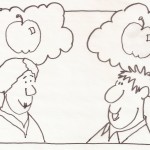Coaching Challenge: Getting to Yes
 Every day at work involves some kind of negotiation, whether it’s simply when to schedule a conference call, or a more complex issue such as where to cut costs on next year’s budget. We wrestle with the pros and cons and usually come to consensus…or someone simply acquiesces and moves on.
Every day at work involves some kind of negotiation, whether it’s simply when to schedule a conference call, or a more complex issue such as where to cut costs on next year’s budget. We wrestle with the pros and cons and usually come to consensus…or someone simply acquiesces and moves on.
However, there are occasions when issues become really thorny. Someone digs in and won’t budge. “Getting to yes” is subverted by getting nowhere.
In this case, an individual is often identified as the problem: “He’s so stubborn and won’t listen to what I think should happen.” “She thinks she knows all the answers, but this is more complicated than she realizes.”
Coaching can help move people outside their comfort zone and beyond their “positions” by letting them deal with difficult personalities and find common ground. Managers who coach individuals and teams through these difficulties can guide a problem-solving process that may have benefits beyond the roadblock issue: the outcome may include greater self-awareness, improved communication, cost and time efficiencies, and more.
Reframing
Coaching conversations can help to reframe a situation, enabling someone stuck in a position to look at it from another perspective and consider others’ viewpoints. For example, coaching can help someone with a negative outlook to see the pros instead of the cons: what is working rather than what isn’t; what opportunities are out there vs. what barriers may exist.
Anticipating and planning for hurdles
Coaching might include role playing the worst that could happen, giving a “glass half empty” person the chance to test the likelihood of all those downside possibilities. Then there’s the opportunity to anticipate the upside, and how to make it happen.
Appreciating different styles
Coaching can help us better understand our work and communication styles, and those of co-workers. We can identify particular strengths and call upon them to facilitate cooperation. Appreciating different styles can open the way to better ways of collaborating and communicating, so all parties are heard and understood.
Thinking deeply
Finally, coaching’s emphasis on engaged listening and deliberative questioning enables the coachee to think more deeply about threads and patterns—when his coworker has not been unpleasant, when she has been more collaborative. Identifying these positive patterns can encourage more successful interactions going forward.
Thinking more deeply can also provide better insight into what triggers difficult exchanges in the first place, and ways to avoid those triggers in the future. Small behavior changes are the stepping-stones to healthier, more collaborative working relationships.
Because coaching is solutions-focused, managers who coach can help their people recognize and accommodate different styles and points of view in working to a common goal.
What have you found works in working with difficult personalities?
If you found this post helpful, check out “About the Book” on this blog, and order yourself a copy of “What could happen if you do nothing?” A manager’s handbook for coaching conversations.








